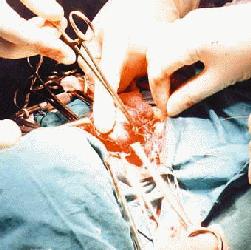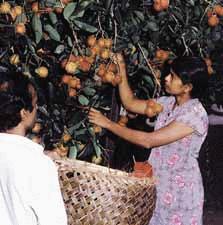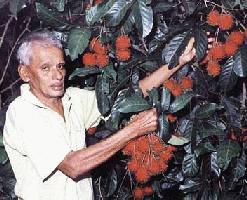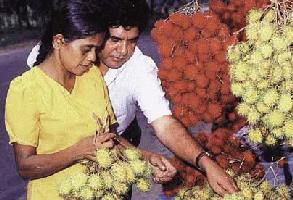

![]()
The problem of a malfunctioning and diseased thyroid is frequently found in Sri Lanka. One reason is the lack of iodine both in water and the soil especially in the upcountry areas. Surgical operations for thyroid are done and the thyroid gland removed only if there is cancer, otherwise only a lobe of the thyroid is removed.
Goiter is the unseemly appendage to a toxic thyroid. Dr. S. A. W. Gunewardena of the Sri Jayewardenepura hospital has done two thousand thyroid operations upto now. He is not only a competent surgeon but also a good teacher and he explained the thyroid operation, step by step.
Before beginning the operation, Dr. Gunewardena took time to explain that there were many reasons for the need to perform a goiter operation. First for cosmetic effect because a goiter is unsightly and gross. Next, a thyroid gland can become toxic and then one can lose weight though there is sometimes an increased appetite too.
In women the problem can cause irregular menstruation. Actually it is a morbid thought that women are more prone to thyroid defects than men. This, the doctor explained, is due to the fact that thyroid hormones are reduced in women during pregnancy and during menstruation.
Toxic thyroids cause the bulging of the eyes causing a change in vision and it also affects the nervous system. Toxic thyroid also affects the heart and sometimes causes heart failure.
 Tbe
surgeon works dexterously.
Tbe
surgeon works dexterously.
Getting back to the operation in the
theatre there was a guide chart inscribed with pithy notations saying: ‘gauze
and towels’, ‘gauze and swabs’, ‘blood loss’ and ‘abdominal
pads’ etc.
The patient lay beneath the sterile germ free cloth as the doctor made his first cut. He opened the skin and held the skin apart with a retractor. This was an operation on the right lobe of the thyroid. Very efficiently, the surgeon and his assistant Dr. Mahanama Gunesekera gave the patient’s open wound several injections with a large syringe. This was to stop bleeding. So the myth that this operation causes much blood loss is no longer correct with modern techniques in use.
And there was the surgeon who worked dexterously cutting and burning the right lobe of the goiter as an eerie silence prevailed. For the diathermy probe the white gloved finger of the surgeon probed and cut while an iodine lotion floated around the wound. If a nerve in the vocal cord gets cut the patient can lose his or her voice. Just a nip is enough. And if one of the surrounding blood vessels taking blood to the brain gets nipped one can become a human vegetable.
So though the surgeon appeared to be relaxed it required much skill. It is a delicate operation. There were sutures both internal and external, sewn with linen-silk thread to stop bleeding points too. Finally to everybody’s relief the surgeon extracted the right diseased lobe of the thyroid gland. He took it aside and dissected it and said he would send it for biopsy to see whether it was cancerous. If it unfortunately was found to be so, the left lobe too would be removed later.
It is however a happy thought that one can live without both thyroid glands on a dose of one thyroxin tablet a day which comes in 25, 50, or 150 gms. Generally a dose of 100 or 150 gms a day is most effective. When the woman was once more fully awake she would have found to her utter relief and joy that the unsightly goiter mass which had marred her looks gone as if by a miracle.
Our thanks once again to all those who helped us watch the operation especially the chief surgeon S. A. W. Gunewardene, his assistant Mahanama Gunesekara and the consultant anaesthetist Savithri Wijesekera. The Sunday Times also thanks the Management of Sri Jayewardenepura hospital.
Malwana- the very name conjures up memories of heaps of luscious red rambutans. Street vendors in the city selling the fruit call out ' Malwana pani rambutan'- testimony that rambutans grown elsewhere are not a patch on the Malwana type.
To see for ourselves what it is that gave Malwana its unique reputation of providing the country's best rambutans, we plied the road to Biyagama, arriving at this famous village, a few kilometres away from the Biyagama Export Processing Zone. Even in the evening light , the trees that line the road seem to glow in hues of red and yellow. Like bulbs strung on the trees, rambutans weigh down on the branches. Every house seems to have several rambutan trees in the garden and as we passed by people peered into the vehicle looking for customers to sell the fruit. Rambutans are not indigenous to Sri Lanka, but in Malwana they seem to have found a home as good as their original lands in Malaysia. It is this little village area that supplies the majority of the country's requirement of the fruit when it is in season in July and August. The older, larger rambutan trees, called wal or wild rambutans have now given way to newer varieties, budded trees that are only as high as a person but yield more fruits which are bigger and juicier.
 Harvesting: many opt for shorter varieties.
Harvesting: many opt for shorter varieties.
In Malwana there are families who totally depend on the rambutan harvest for their income. Others have transformed their gardens into rambutan plantations. From a high yielding tree one could earn upto Rs. 10000 during the season. But the majority are those who do regular jobs or work in the fields and the income they get from selling the fruits during rambutan season is merely an extra.
Against the dark green of the rambutan leaf, the fruit is colourfully obvious. This makes it a good target for bats and birds who sometimes ravage entire trees overnight. To protect the rambutans, which are of monetary value to them, the residents flood light their trees at night and employ many other methods of protecting the trees. Some affix a noisy improvised bell like gadget which rings out at the slightest movement scaring off bats. Others employ scarecrows.
A newspaper reported recently that a rambutan farmer in Beruwela employs his dogs to watch the crop. The canine watchguards have a hut atop the trees and every evening after a meal, they are led up a ladder by the owner, and they spend the night there protecting the fruit not only from animals but also from petty thieves.
The General Hospital's Accident Ward already has had many casualties of failed rambutan harvesting. People falling off rambutan trees and breaking their bones is a common occurrence at this time of the year, says Accident Ward Director, Dr. Hector Weerasinghe. He said there was one person who had been paralysed entirely following injury after a fall from a rambutan tree. These trees are particularly dangerous because their higher branches are not very strong and the lure of rambutans may lead people to unnecessarily risk their lives. Even children have been admitted to hospital with fractures from rambutan tree accidents.
Those growing the fruit on a commercial basis, opt for the shorter budded trees, which makes picking very easy. These trees also have a higher yield and the fruit is more palatable. There are several budded rambutan varieties but the Malwana Special is most popular.
 Upadasa: going to chop down all trees.
Upadasa: going to chop down all trees.
D. K. Upadasa , a former teacher who now lives on his pension and his 41/2 acre rambutan plantation lamented that he has not been able to sell many rambutans this year. "Vendors say that they are being chased from the pavements in Colombo by the police. The city is our biggest market. If this year I do not get a good sale I am going to chop down all these trees and plant coconut," said the elderly man, gesturing towards his large extent of fruit laden trees. Upadasa employs 11 people to work in his fields and the entire garden is flood lit at night. "My electricity and wages bill is so high during the season, sometimes the income from the fruits is just not sufficient."
He worries that if his fruit is not sold, he will have to pay these bills from his meagre pension.
 Varieties to choose from: yellow and red on sale.
Varieties to choose from: yellow and red on sale.
Rambutan was introduced to this country a couple of centuries ago by the Dutch. The Agriculture Department says that there are some 14 varieties of which nine, recently introduced, bear budded fruits. They agree that the Malwana Special is the best of the lot because it has an attractive deep red colour, the flesh comes off easily from the seed and the taste is much sweeter.
The Department claims that rambutan can be grown in any wet zone area with the same success as in Malwana. Malwana's popularity grew when in the 1950s villagers planted budded varieties and began actively selling plants and fruits to the market. Although rambutan cultivation has spread Malwane still stands out
So before the season comes to a close enjoy those succulent rambutans, even if they are a little expensive. For another year, the only other rambutans you would see would be in imported tins on supermarket shelves. And never will they be as tasty an experience as those juicy Malwana Specials.
Continue to Plus page 5 - The natural way is best
Return to the Plus contents page
![]()
| HOME PAGE | FRONT PAGE | EDITORIAL/OPINION | NEWS / COMMENT | BUSINESS
Please send your comments and suggestions on this web site to
info@suntimes.is.lk or to
webmaster@infolabs.is.lk